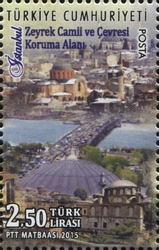Stamp: Our works in UNESCO's World Heritage List (Istanbul) (Turkey 2015)
Our works in UNESCO's World Heritage List (Istanbul) (Turkey 2015)
21 May (Turkey ) within release Our works in UNESCO's World Heritage List (Istanbul) goes into circulation Stamp Our works in UNESCO's World Heritage List (Istanbul) face value 2.50 Turkish old lira
| Stamp Our works in UNESCO's World Heritage List (Istanbul) in catalogues | |
|---|---|
| WADP Numbering System - WNS: | WAD:TR036.15 |
Stamp is vertical format.
Also in the issue Our works in UNESCO's World Heritage List (Istanbul):
- Stamp - Our works in UNESCO's World Heritage List (Istanbul) face value 1.25;
- Stamp - Our works in UNESCO's World Heritage List (Istanbul) face value 1.25;
- Stamp - Our works in UNESCO's World Heritage List (Istanbul) face value 2.50;
- Stamp - Our works in UNESCO's World Heritage List (Istanbul) face value 2.50;
- Mini Sheet - Our works in UNESCO's World Heritage List (Istanbul) face value ;
Stamp Our works in UNESCO's World Heritage List (Istanbul) it reflects the thematic directions:
Architecture (Latin architectura, from the Greek ἀρχιτέκτων arkhitekton "architect", from ἀρχι- "chief" and τέκτων "builder") is both the process and the product of planning, designing, and constructing buildings and other physical structures. Architectural works, in the material form of buildings, are often perceived as cultural symbols and as works of art. Historical civilizations are often identified with their surviving architectural achievements.
Engineering is the practice of using natural science, mathematics, and the engineering design process to solve problems within technology, increase efficiency and productivity, and improve systems. Modern engineering comprises many subfields which include designing and improving infrastructure, machinery, vehicles, electronics, materials, and energy systems
Classical antiquity, also known as the classical era, classical period, classical age, or simply antiquity, is the period of cultural European history between the 8th century BC and the 5th century AD. It comprises the interwoven civilizations of ancient Greece and Rome, known together as the Greco-Roman world, which played a major role in shaping the culture of the Mediterranean Basin. It is the period during which ancient Greece and Rome flourished and had major influence throughout much of Europe, North Africa, and West Asia. Classical antiquity was succeeded by the period now known as late antiquity.
The Department of Environment and Conservation (DEC) was a department of the Government of Western Australia that was responsible for implementing the state's conservation and environment legislation and regulations. It was formed on 1 July 2006 by the amalgamation of the Department of Environment and the Department of Conservation and Land Management.
A bridge is a structure built to span physical obstacles without closing the way underneath such as a body of water, valley, or road, for the purpose of providing passage over the obstacle. There are many different designs that each serve a particular purpose and apply to different situations. Designs of bridges vary depending on the function of the bridge, the nature of the terrain where the bridge is constructed and anchored, the material used to make it, and the funds available to build it.



